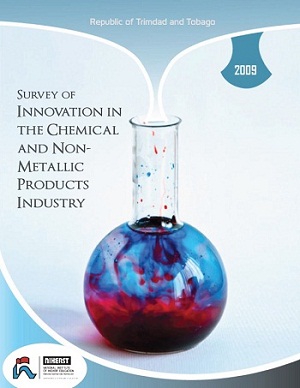
The National Institute of Higher Education, Research, Science and Technology (NIHERST) conducted a national survey on innovation in the Chemical and Non-metallic Products Industry in 2009.
The results of the survey should provide insights into the innovation process and assist decision makers in developing policies to create the environment and incentives that are necessary to catalyse innovation in the industry.
Summary of Main Findings
Innovation Activities
- The majority of responding establishments (73%) was local/privately owned. There was a relatively small percentage of licensing contracts for product or process technology. Virtually no outsourcing arrangements are in place. Licensing/outsourcing arrangements with foreign establishments were therefore not significant mechanisms for the transfer of technology and the diffusion of innovation in the sector. The importation of machinery and equipment pointed to the possible diffusion of innovation through the use of embodied technology.
- Product innovation was more prevalent amongst older establishments, and was more widely practised than process innovation. Fifty percent (50%) of the establishments indicated that they had introduced a new product, compared to twenty-seven percent (27%) that introduced a new process. A similar percentage (46%) of the respondents had improved an existing product and an existing process. Product and process innovation were more prevalent amongst larger establishments with fifty (50) employees and more.
- The main areas of focus with respect to organisational innovation were the introduction/improvement of quality assurance systems, and changes in management systems and techniques (61%), the introduction/ expansion of in-house training (58%), followed by the improvement of maintenance systems (54%). The larger establishments employing fifty (50) persons and more predominated in all of the categories of organisational innovation.
- With respect to marketing innovation, forty-six percent (46%) of the establishments reported the introduction of new marketing techniques, while 38% developed new markets at home or abroad. Establishments in all the sub-sectors participated, to some extent, in innovative marketing activities.
Driving Forces and Obstacles to Innovation
- The following reasons for innovating were cited by respondents as very important:
- Improve productivity (69%)
- Customer satisfaction (65%)
- Reduce production cost (65%)
- Improve product (61%)
- The lowest ranking was given to extending the product range with only thirty-one percent (31%) of respondents reporting this to be very important.
- The main obstacles to innovation were identified as the lack of skilled/qualified personnel and high cost of the innovation project, followed by lack of information and domestic economic conditions. More respondents considered lack of financing to be not relevant/ appropriate (35%) than to be very significant (23%).
Linkages and Collaboration
- Customers were rated as very important sources of information for innovation by 54% of the respondents; similar ratings were given to in-house information (46%), suppliers (23%) and the parent establishment (23%). With respect to education and research institutions, 23% and 19% of respondents reported that they were very important and moderately important, respectively, while 35% stated that they were not used. Only 4% of respondents considered government ministries or public research institutions to be very important, while 27% indicated that they were moderately important and 42% did not use their services.
- Customers were identified as the most significant source with respect to entry into co-operative/collaborative arrangements (31%), followed by associated establishments and suppliers (27%). Twenty-three percent (23%) of respondents had been involved in collaborative activity with universities and higher education institutions, while 15% acknowledged similar activity with private research institutions and government ministries.
Impact of Innovation
- The impact of innovation was reported to be greatest with respect to increased productivity (56%), competitiveness (58%) and profitability (54%). Between 42-46% recorded increases in export growth, product differentiation, service quality and cash flow, while 31% reported increased employment and domestic market share. Twenty-three percent (23%) attributed increased diversification and improved compliance with regulators to their innovative activities. Only 15% of respondents reported that innovation had a positive environmental impact.
Research and Development
- Approximately one-third (31%) of the establishments indicated that they had undertaken research and development, while 65% responded negatively. This is consistent with the relatively low number of scientists and engineers employed, with 23% of respondents employing no scientists and engineers, and 50% employing between 1 3 scientists and engineers. Only one establishment utilised patents to protect its intellectual property. Others, however, utilised trademarks, confidentiality agreements and trade secrets to some extent to protect their intellectual property.
Role of Government
- The majority of respondents (88%) had not utilised government support or assistance in their innovation activity. Government support programmes were viewed as non- applicable by an overwhelming 92% of establishments. Compliance with local laws or standards was identified as very important for innovation by 58% of respondents, while only 15% reported that their innovative activity had a positive environmental impact.
- Government or public research institutions were rated as very/moderately important sources of information (31% of respondents). Collaboration with government ministries was acknowledged by 15% of respondents, with a mere 4% collaborating with public research institutions. However, 23% of respondents stated that legislation/legal restrictions/administrative procedures were very/moderately significant obstacles to innovative activity.
- Respondents indicated that government can encourage innovation in establishments by:
- Reducing taxes and duties
- Providing grants and intellectual capital to support the innovation process
- Providing concessions on R&D equipment and expenditures
- Providing workshop/ engineering support to design and build machinery
- Providing qualified engineering consultancy support; providing research and development information
- Placing continued emphasis on education for skills
- Revitalising R&D in agriculture






